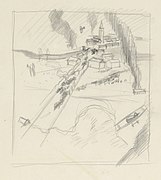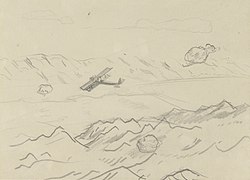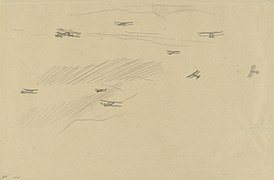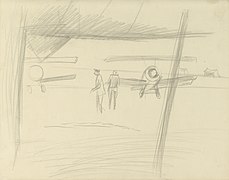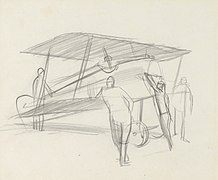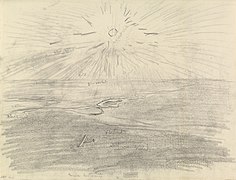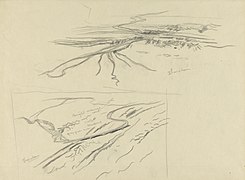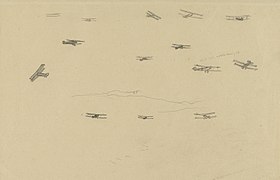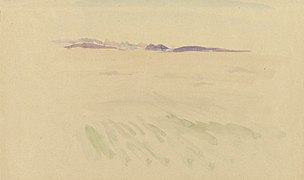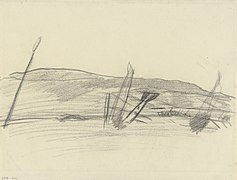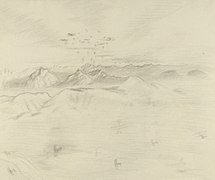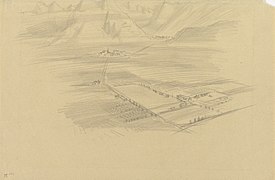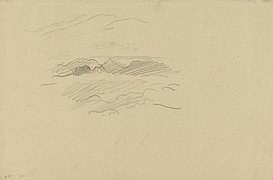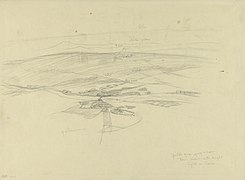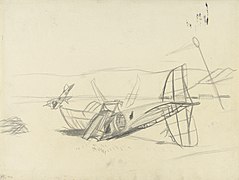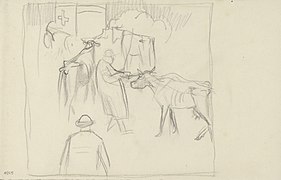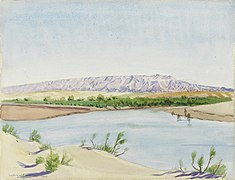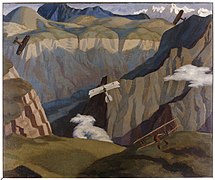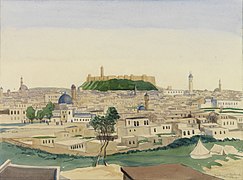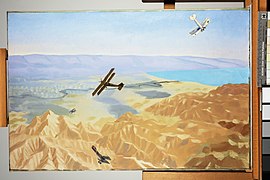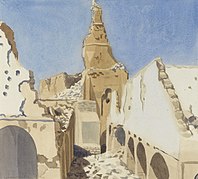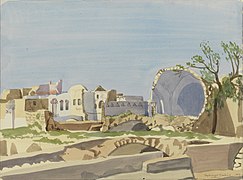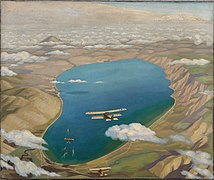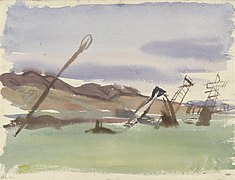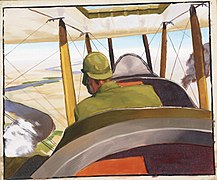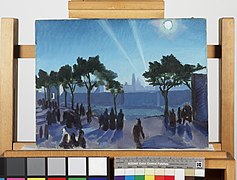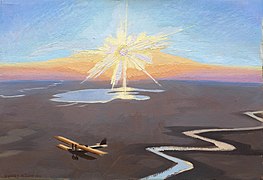Sydney Carline
Sydney William Carline (* 14. August 1888 in London, Vereinigtes Königreich; † 14. Februar 1929 ebendort) war ein britischer Maler und Lehrer. Er war bekannt für seine Luftkampfdarstellungen.
Leben
Sydney Carline war der Sohn des Künstlers George Carline. Er wurde 1888 in London geboren, seine Geschwister Richard Carline und Hilda Carline waren ebenfalls Künstler. Sydney Carline war Maler, Zeichner und Medaillengewinner. Er malte vor allem Landschaften und Porträts,[1] sein Studium absolvierte er an der Slade School of Fine Art von 1907 bis 1910 und später in Paris. Als der Erste Weltkrieg ausbrach, trat er gemeinsam mit seinem Bruder Richard der Royalen Flugstaffel bei und diente an der Westfront im Mittleren Osten. Während seiner Zeit in Palästina stellte er sein berühmtestes Kriegsbild her - The Destruction of the Turkish Transport. Um das Jahr 1918 wurde Sydney als berühmter Maler bekannt.[2] Richard und Sydney hatten die Aufgabe die Ereignisse auf Kriegsschauplätzen zu dokumentieren, darzustellen und dadurch für die Ewigkeit sowohl Siege als auch schmerzliche Niederlagen, wie etwa die Belagerung von Kut al-Amara, festzuhalten.[3] Die meisten Gemälde stellten Luftkämpfe und das Leben als Pilot bei den Royal Flying Corps bzw. bei der Royal Air Force dar. Sydney Carline war einer der ersten Piloten bei den Royal Flying Corps.[4] In einigen Ölgemälden Carlines nimmt der Betrachter den Platz des Piloten ein und folgt den Linien anderer Flugzeuge über Landschaften und durch Rauchwolken. Die von Carline eingesetzten Farben bewirken, dass die Landschaft einengend wirkt.[5]
Während des Ersten Weltkriegs
Als der Erste Weltkrieg ausbrach, trat Carline der britischen Armee bei, zunächst als Kurier, bis er 1916 Pilot in der Royalen Flugstaffel wurde. In Frankreich wurde er angeschossen und verwundet. Er überlebte und wurde daraufhin Pilot eines einsitzigen Flugzeuges genannt Sopwith Camel, an der italienischen Front, bis Ende 1917.[6] Während seiner Zeit in Italien richtete er sich ein Atelier in einem Museum in Vicenza ein. Bis Februar 1918 skizzierte er dort Kampfszenen, ohne offiziellen Auftrag. Sein Bruder Richard unterstützte ihn dabei ein offizieller Kriegsmaler zu werden. In diesem Rahmen skizzierte er unter anderem von Juli bis November 1918 Luftkämpfe an der italienischen Front.[7] Um diese Luftkämpfe möglichst gut dokumentieren zu können, wurde er aufgrund seiner Pilotenerfahrung wurde der RAF-Sektion zugeteilt.[8]
1919 schickte das Imperial War Museum Sydney und Richard in den Mittleren Osten. Als offizielle Kriegsmaler der Royal Air Force war es ihre Aufgabe die Luftkämpfe darzustellen. Sie bereisten die Region rund um Jerusalem. Neben ihren militärischen Pflichten besuchten sie auch historische und archäologische Orte. In Wadi Fara fertigten sie einige Skizzen an, welche später wahrscheinlich das Werk The Destruction of the Turkish Transport in the Gorge of the Wadi Fara, Palestine darstellt. Das Werk bildet einen Angriff auf die türkischen Truppen in einer steilen Schlucht ab. Nachdem die Brüder einige Zeit in Beirut verbrachten, wurden sie nach Kairo und danach nach Bagdad geschickt. Schließlich wurden sie nach Mossul geschickt, wo gerade die RAF einen Bombenangriff gegen die kurdischen Aufständischen plante. Bevor dieser jedoch 1919 ausgeführt werden konnte, wurden die beiden wieder nach England zurückberufen.[6]
Nach dem Krieg unterrichtete Sydney Carline in Oxford, 1922 wurde er Mitglied der London Group.[1] 1920 stellten die beiden Brüder Richard und Sydney ihre Gemälde bei einer Ausstellung aus. Sechs Jahre später illustrierte Sydney T. E. Lawrences Aufstand in der Wüste.[2] 1920 stellten die beiden Brüder ihre Arbeiten, welche in Palästina und Mesopotamien angefertigt wurden in der Goupil Gallery in London aus. Wobei sich einige der ausgestellten Bilder nicht auf den Krieg bezogen, wie etwa die beiden Bilder Mount Hermon and Mount Sannin above the Clouds, Palestine und Jerusalem and the Dead Sea from an Aeroplane, welche von Richard Carline gefertigt wurden. Zur damaligen Zeit war es nur einem sehr kleinen Teil der Bevölkerung möglich zu fliegen. Die Bilder kennzeichnen somit die für immer bestehenden Sehenswürdigkeiten des Heiligen Landes und den technischen Fortschritt. In vielen Bildern ist die britische Militärpräsenz nicht sichtbar, stattdessen ist auf den Bildern die Landschaft des Heiligen Landes abgebildet.[9]
Tod und Nachlass
Aufgrund von Finanzierungsengpässen kaufte die RAF-Sektion des Imperial War Museum (IWM) nicht so viele Gemälde wie erwartet. Nach Carlines Tod bot Richard dem Museum weitere Zeichnungen und Gemälde, aus der Zeit als Carline für das Museum arbeitete an. Über hundert Arbeiten Carlines wurden an das Museum übergeben. Auch an die Usher Art Gallery in Lincoln wurden 1929 Werke Carlines für eine Ausstellung verborgt.[10]
Werkeliste nach Galerien
The Ashmolean Museum of Art and Archeology
- Over the Hills of Kurdistan: Flying above Kirkuk (1919)
Usher Gallery
- Village by Lake Orta, Italy
Manchester Art Gallery
- The Walnut Tree (1928)
Ruskin School of Drawing and Fine Art, University of Oxford
- Self Portrait
Rozelle House Galleries
- Snow in Hampstead (1926)
IWM (Imperial War Museum) London
- Among the Anti-Aircraft Bursts at 20,000 Feet above the Alps: A British Air Squadron Crossing the Anglo-Austrian Line along the River Piave, Italy (1918)
- A Destroyed Turkish Aerodrome at Rayak, Lebanon, 1919 (1920)
- Aerodrome with Camouflaged Hangars (1918)
- “Sopwith Camel” Patrol Attacking an Austrian Aerodrome near Sacile, Italy (1918)
- A British Pilot in a BE2c Approaching Hit along the Course of the River Euphrates, Juli (1919)
- “Sopwith Camel” Patrol Attacking Austrian Troops Retreating along the Road to Udine, Italy (1918)
- The Dead Sea: An Enemy Aeroplane over the Dead Sea, Palestine (1920)
- Study for “The Dead Sea: An Enemy Aeroplane over the Dead Sea, Palestine” (1920)
- Austrian Dugout beyond Mount Grappa after the Italian Advance of October 1918 (1918)
- British Scouts Leaving Their Aerodrome on Patrol over the Asiago Plateau, Italy (1918)
- Two British Planes Attacking the Turkish Army Corps in the Gorge of the Wadi Baroda, Lebanon, 30. September 1918 (1919)
- Study for “The Dead Sea: An Enemy Aeroplane over the Dead Sea, Palestine” (1919)
- Flying over the Desert at Sunset, Mesopotamia (1919)
- The Sea of Galilee: Aeroplanes Attacking Turkish Boats (1919)
- The Destruction of the Turkish Transport in the Gorge of the Wadi Fara, Palestine (1920)
- Study for “The Destruction of the Turkish Transport in the Gorge of the Wadi Fara, Palestine” (1919)
- The Hills of Judea (1919)
- The Destruction of an Austrian Machine in the Gorge of the Brenta Valley, Italy (1918)
- Austrian Prisoners Driven in from the Austrian Lines (1918)
- British “Maurice Farman” Attacked by a German “Fokker” While Dropping Sacks of Corn on Kut-el-Amara during the Siege of 1916 (1919)
- Italians Leaving Padua on Account of the Raids (1918)
Calderdale Metropolitan Borough Council
- Mostar, Herzegovina (1922)
Royal Air Force Museum
- Italian Front (1918)
York Museums Trust
- The Trail of War (1919)
Tate
- Bank Holiday on Hampstead Heath (1915)
- St. John’s, Downshire Hill, Hampstead (1927–28)
Quelle:[11]
Galerie
- Skizzen Sydney Carline
- Gemälde Sydney Carline
Literatur
- Merion Harries, Susie Harries: The War Artists. British Official War Art of the Twentieth Century. Hrsg.: Michael Joseph with The Imperial War Museum & the Tate Gallery, London 1983, ISBN 071812314X
Weblinks
- Art UK, Artworks by Sydney William Carline, abgerufen am 1. April 2018
Einzelnachweise
- ↑ a b Benezit Dictionary of British Graphic Artists and Illustrators. Band 1. Oxford University Press, Oxford, New York 2012, ISBN 978-0-19-992305-2, S. 215.
- ↑ a b John Simkin: Sydney Carline. In: Spartacus Educational. August 2014, abgerufen am 5. Februar 2018.
- ↑ Michael J. K. Walsh, Andrekos Varnava: The Great War and the British Empire: Culture and Society. Routledge, Taylor & Francis Group, London/New York 2017, ISBN 978-1-4724-6227-5, S. 18.
- ↑ John Fairley: Horses of the Great War: The Story in Art. Pen and Sword Military, South Yorkshire 2015, ISBN 978-1-4738-4826-9, S. 160.
- ↑ Clare Saxby: War in the sunshine. In: The times Literary supplement. 1. Februar 2017, abgerufen am 16. Februar 2018.
- ↑ a b Merion Harries & Susie Harries: The War Artists. British Official War Art of the Twentieth Century. Hrsg.: Michael Joseph with The Imperial War Museum & the Tate Gallery. 1st edition Auflage. London 1983, ISBN 0-7181-2314-X, S. 310.
- ↑ Laura Cumming: War in the Sunshine. In: The Observer. 15. Januar 2017, abgerufen am 15. Februar 2018.
- ↑ War in the Sunshine: The British in Italy 1917–1918. In: Art Fund. 2017, abgerufen am 16. Februar 2018.
- ↑ Rory Miller: Britain, Palestine and Empire: The Mandate Years. Routledge, Taylor & Francis Group, London, New York 2016, ISBN 978-0-7546-6808-4, S. 89,90.
- ↑ IWM: Carline, Sydney. 2018, abgerufen am 15. Februar 2018.
- ↑ Discover Artworks, Sdney William Carline. In: ART UK. Abgerufen am 15. Februar 2018.
| Personendaten | |
|---|---|
| NAME | Carline, Sydney |
| ALTERNATIVNAMEN | Carline, Sydney William (vollständiger Name) |
| KURZBESCHREIBUNG | britischer Maler und Lehrer |
| GEBURTSDATUM | 14. August 1888 |
| GEBURTSORT | London |
| STERBEDATUM | 14. Februar 1929 |
| STERBEORT | London |
Auf dieser Seite verwendete Medien
Sketch of Flying Aircraft, Italy, 1918
image: a sketch of fourteen biplanes in flight. The aircraft are shown from different angles, with the outline of a mountain range in the middle of the composition.
Aleppo, Syria, 1919
image: a view overlooking the city of Aleppo showing the white, flat-roofed buildings and minarets of domed mosques. In
the distance is a large fortification built on a grassy mound. Three tents are pitched in the lower right foreground.Sketch for 'flying Above Kirkuk, Kurdistan, 1919' (iwm Art 4638)
image: an aerial view of Kirkuk with hills beyond. The drawing is annotated with colour notes.
Study for 'flying Over the Desert at Sunset, Mesopotamia, 1919' (iwm Art 4623)
image: a rough sketch of a bright sun blazing over a Mesopotamian landscape with an RAF biplane in flight and the Euphrates river beneath. The drawing is annotated with colour notes.
Five Studies of Aerial Views, Italy, 1918
image: a cartoon showing five small squared up aerial views of the Italian landscape. The studies show rolling hills, roads and the small buildings of villages. The study in the upper centre also includes two RAF biplanes.
Study for 'a Destroyed Turkish Aerodrome at Rayak, Lebanon, Syria' (iwm Art 3139)
image: two burnt-out aircraft with the hangars of Rayak aerodrome in the distance. There is a wind-sock flying in the right of the composition and hill peaks dominate the horizon.
A British Pilot in a Be2c approaching Hit along the course of the River Euphrates, July 1919.
image: The back view of a pilot from the rear cockpit of a BE2C. The struts and wires of the wing structure surround the pilot, who wears helmet and goggles and is looking down and to his left, leaning slightly out of the cockpit. The River Euphrates runs below, winding across a flat plain. In the lower left there is a small puff of white smoke, and in the centre right a plume of black smoke
can be seen through the wires of the wing. A pink haze of dust fills the horizon in the upper background.Flying Above Kirkuk, Kurdistan, 1919
image: an aerial view from the rear cockpit of an RAF biplane showing the tail of the aircraft and three other planes following
behind. The town of Kirkuk and the outlines of fields, including an airfield, are visible below, and in the distance there are rolling foothills leading up to high mountains.Kut-el-amara, 1919
image: a view across a bomb damaged quarter of the city of Kut in Mesopotamia, seen from the roof of a house. Date palms grow between the houses, and the horizon is flat with only desert beyond the city boundary.
The Sea of Galilee- Aeroplanes Attacking Turkish Boats, 1919
image: A high altitude aerial view of the Sea of Galilee. It is flanked by hills on the right-hand shore, the Jordan river lower left and a snow-capped Mount Hermon rising above the clouds in the upper right of the composition. Three aircraft fly towards the
lake, where several dark shapes of Turkish motorboats setting off from the shore are visible.Aircraft and Aerial Views, July 1919
image: sketches of aerial views of a river, possibly the Euphrates, and five biplanes in flight. The drawing is
annotated with colour notes.Study for 'the Dead Sea- An Enemy Aeroplane over the Dead Sea, Palestine' (iwm Art 3079)
image: A study showing an aircraft flying in the top right of the composition with the Dead Sea to the right, the valley of the River Jordan mid-ground and the blue Hills of Moab in the distance. Three British planes prepare to engage in a dogfight in the
lower left. A towering cloud pattern dominates the centre background.Ruins of Gaza, Egypt, 1919
image: a view over the ruins of a town of white, flat roofed buildings, with the remains of a large, arched building to
the right.Italians Leaving Padua on Account of the Raids, 1918
image: A night scene outside the city walls of Padua. Groups of figures stand and walk along a tree-lined road, some
looking back at two searchlights forming a V in the night sky above the town. A full, pale moon shines in the upper right.Red Cross Ambulance and Farm Animals, Italy, 1918
image: a sketch of three malnourished cows behind a motor ambulance. A man struggles to encourage one of the animals to move, whilst another man looks on in the immediate foreground.
Temporary Canvas Hangar for a Biplane, Italy, 1918
image: a scene showing a temporary canvas hangar with two sides pulled up and RAF ground crew manoeuvering a biplane into
position. There is a line of trees to the right and the foothills of the Italian Alps are silhouetted against the horizon.Flying Over the Desert at Sunset, Mesopotamia, 1919
image: An unnaturally bright sun blazes over a landscape with a river. There is an aircraft flying over the desert in the
lower right of the composition.Study for 'a Destroyed Turkish Aerodrome at Rayak, Lebanon, Syria' (iwm Art 3139)
image: a watercolour sketch of three burnt-out aircraft with their noses buried in the ground, the leaning pole of a wind-sock to the left of the composition, and hills in the background.
Aerial View over the Asiago Plateau, Italy, 1918
image: a brief watercolour sketch of the view over the Asiago Plateau with the foothills of the Italian Alps rising above the cloud in the distance.
Study for 'the Dead Sea' (iwm Art 3079)
image: an aerial view of an RAF biplane in action over the Dead Sea. The River Jordan runs across the valley on the left to the the Dead Sea on the right. The hills of Moab line the horizon. A biplane flies away from the viewer in the centre of the composition, surrounded by puffs of anti-aircraft fire.
Study for 'a Destroyed Turkish Aerodrome at Rayak, Lebanon, Syria' (iwm Art 3139)
image: a rough sketch of burnt-out aircraft with their noses buried in the ground at the destroyed Rayak aerodrome. Hills line the horizon and a pole juts from the ground to the left.
The Fatha Position, Northern Mesopotamia- the hill defences held by the Turks in 1918
image: a view across a river with bare hills in the background. Four figures are bathing near the far bank to the
right.The Destruction of an Austrian Machine in the Gorge of the Brenta Valley, Italy
image: An aerial view of an Alpine gorge. An Austrian aircraft flies in the centre of the composition surrounded by three British aircraft, one top left, one top right and one swooping low over the edge of the gorge lower right. The river is visible in the depths of the gorge, lower left centre. A patch of sunlight lights up an Alpine peak top right. Clouds hang amongst the sheer-edged
mountain peaks.Aerial View over the Asiago Plateau, Italy, 1918
image: a sketch of an aerial view over the Asiago Plateau towards the foothills of the Italian Alps. The aerodrome with its
large canvas hangars can be seen below to the right; above and to the left is a village with a church spire. Another village nestles in a valley between the hills in the upper centre.Study for 'among the Anti-aircraft Bursts at 20,000 feet above the Alps' (iwm Art 2677)
image: a preparatory sketch of an aerial view of the Italian Alps with the River Piave below and in the bottom left of the composition. A squadron of seven British biplanes fly away from the viewer and into small puffs of anti-aircraft flak in the centre background. Several other aircraft fly at low altitude in the lower foreground.
Landscape Sketches, July 1919
image: two sketches of aerial views over a Mesopotamian landscape with a winding river, possibly the Euphrates. All are annotated with colour notes, and some areas are named: Sharaban, Kifri, Kizil, Robat.
The Ruins of the Great Mosque, Gaza, Palestine, 1919
image: a view of the ruins of the Great Mosque in Gaza. A narrow piece of wall from the remains of a tower juts into the sky; debris lies amongst the arched vaults in the lower left and right.
Assisting an Injured British Pilot, Italy, October 1918
image: a small watercolour of two ground-crew members assisting an injured pilot from his biplane. They are supporting the
pilot, dressed in full flying gear, one under each arm and ready to lift him onto a stretcher which is being prepared in the foreground. Other ground-crew members look on, and another climbs into the disabled plane. The entrance to a temporary hangar can be seen in the upper right of the compositon.Aerodrome with Camouflaged Hangars
image: A view of the aerodrome on the Asagio plateau with the Italian Alps in the distance. A temporary hangar with a camouflaged roof stands in the centre left of the composition. Green fields lie in the foreground and there is a suggestion of buildings in
the centre mid-ground.Slight Sketch of a Cloudscape over the Italian Alps, 1918
image: a sketch of a cloudscape and mountain tops.
Sopwith Camel Being 'started-up' for Flight, Italy, October 1918
image: a sketch of a Sopwith Camel surrounded by ground crew, with a figure preparing to start-up the
propellor and a pilot in the cockpit.Aerial View of a Village Under Attack, Italy, 1918
image: an aerial view of an Italian village and road under aerial attack. There are burning buildings to the left and right of the composition, either side of a tree-lined road, upon which appear to be Austro-Hungarian transport carts. RAF biplanes swoop down at low altitude amidst clouds of smoke.
View from a Hangar, Italy, 1918
image: a view from inside a temporary canvas aircraft hangar looking out onto an airfield. Two RAF personnel are visible in the centre of the composition, with two Sopwith Camel biplanes on either side of them and further tents in the right background.
Sketch of Flying Aircraft, Italy, 1918
image: a sketch of nine biplanes in flight over a mountainous landscape.



